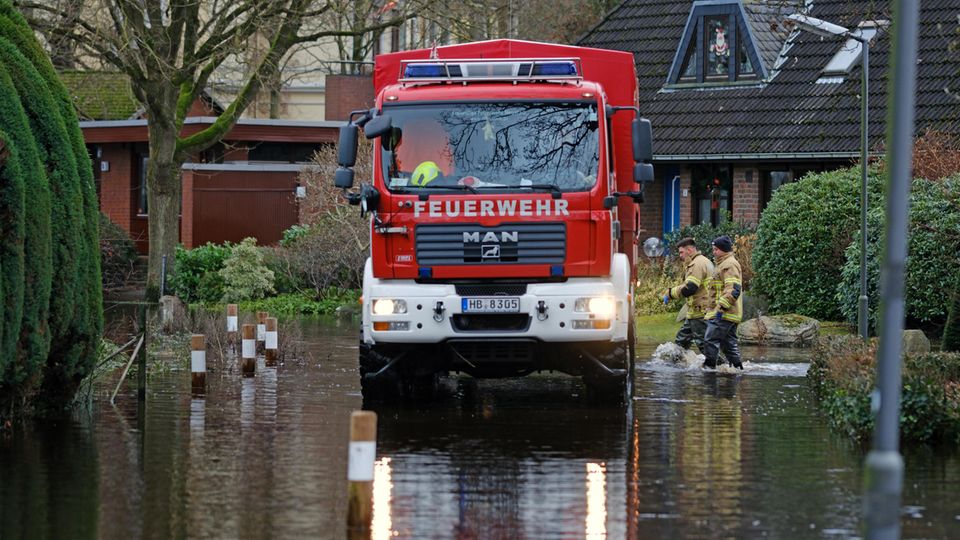Flood
Water levels in Saxony-Anhalt exceeded the highest alert level before Scholz’s visit
Fight against flooding: Sandbags lie along the Helme River at the Kelbra dam in Saxony-Anhalt
© Matthias Bein / DPA
Chancellor Olaf Scholz wants to travel to a flood area again – this time to the Vorharz in the south of Saxony-Anhalt. But people in other areas of Germany are still struggling with masses of water.
The flood situation in the Mansfeld-Südharz district remains tense even before the visit of Chancellor Olaf Scholz (SPD). The water level on the Helme in Bennungen was reported to be 2.42 meters on Thursday morning, exceeding the highest alert level 4. Shortly before the turn of the year, a disaster had already been declared in the district in Saxony-Anhalt. The Helme River had overflowed its banks in places. In the district, the towns of Berga, Kelbra and Bennungen, among others, are affected by the flood, as well as the Sangerhausen district of Oberröblingen.
The Bundeswehr wants to decide promptly on an application for administrative assistance from the district and, according to a spokeswoman, is currently preparing for a deployment in Mansfeld-Südharz. 150 soldiers were required to help fill and lay out sandbags and secure dikes for a week starting on Monday.
Scholz wants to meet helpers in the flood area
Scholz, Federal Environment Minister Steffi Lemke (Greens) and Prime Minister Reiner Haseloff (CDU) want to come to Oberröblingen at midday to get an idea of the situation. A visit to a sandbag filling facility in Berga is also planned. The Chancellor and his companions want to speak to the operations manager, the emergency services, the mayors of affected communities and volunteers. In Berga they also want to comment on the situation. Scholz had already visited flood areas in Lower Saxony on New Year’s Eve.
Meanwhile, the German Weather Service (DWD) has good news for Saxony-Anhalt and also for the flood areas in Lower Saxony. “It’s getting drier, the heavy rains will stop,” announced Cathleen Hickmann from the DWD for Saxony-Anhalt on Thursday. Light drizzle is still expected in some areas over the course of the day and on Friday, but the amounts are no longer the same as those of the past few days. Overall, it will be drier and significantly colder.
Even in Lower Saxony, which was badly hit by floods, the rain is expected to ease on Thursday and in the coming days. A spokesman for the German Weather Service said this morning that there could finally be talk of relaxation in the weather. Rain is expected again on Friday, but little compared to the last few days. Overall, it will be drier and significantly colder. An onset of winter is expected from the weekend with snow showers, permanent frost during the day and slippery conditions with temperatures down to minus seven degrees.

On Thursday morning, however, several water levels on rivers in Lower Saxony were still above the highest reporting level. According to the management report from the State Office for Water Management, Coasts and Nature Conservation (NLWKN), it was 15 centimeters in Nienburg and Drakenburg. The authority reported increased water levels for numerous water levels on the Weser, but in some places they also fell minimally.
The situation also remains tense on the Aller. In Celle and Eitze the water level on Thursday morning was around 60 centimeters above the highest reporting level, and in other places such as Rethem and Ahlden it was more than 20 centimeters each. On the Leine, the water level was also above the highest reporting level in several areas – for example in Neustadt and Schwarmstedt. According to the NLWKN, if the third reporting level is reached, there is a risk of flooding of larger areas as well as individual properties, streets and cellars.
10 pictures
The situation in the districts of Celle, Oldenburg, Emsland, Osterholz, the Heidekreis and Verden is problematic – as it has been for several days. A so-called extraordinary event has therefore still been detected in these municipalities. This means that districts or cities can, for example, more easily access auxiliary staff.
The situation in other federal states also remains tense for the time being. The State Office for Nature, Environment and Consumer Protection in North Rhine-Westphalia reported rising water levels in parts of the Weser and Rhine. In Thuringia, too, the water levels in the upper Werra, the Ilm and the upper Saale rose after the continuous rain in the Thuringian Forest.


